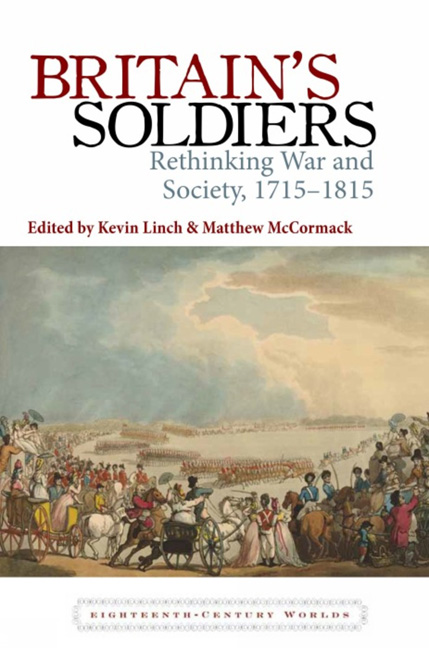Book contents
- Frontmatter
- Contents
- List of tables and figures
- Acknowledgements
- Notes on the contributors
- Introduction
- Part 1 Nationhood
- Part 2 Hierarchy
- Part 3 Discipline
- Part 4 Gender
- 7 Conflicts of Conduct: British Masculinity and Military Painting in the Wake of the Siege of Gibraltar
- 8 Scarlet Fever: Female Enthusiasm for Men in Uniform, 1780–1815
- Part 5 Soldiers in Society
- Index
7 - Conflicts of Conduct: British Masculinity and Military Painting in the Wake of the Siege of Gibraltar
from Part 4 - Gender
- Frontmatter
- Contents
- List of tables and figures
- Acknowledgements
- Notes on the contributors
- Introduction
- Part 1 Nationhood
- Part 2 Hierarchy
- Part 3 Discipline
- Part 4 Gender
- 7 Conflicts of Conduct: British Masculinity and Military Painting in the Wake of the Siege of Gibraltar
- 8 Scarlet Fever: Female Enthusiasm for Men in Uniform, 1780–1815
- Part 5 Soldiers in Society
- Index
Summary
BRITISH VICTORY at the Siege of Gibraltar (1779–83) was achieved in the midst of overwhelming British defeat in the American Revolutionary War. This victory was subsequently represented in several large-scale pictures, painted by leading contemporary artists. John Trumbull's The Sortieof the Garrison at Gibraltar (painted 1789, Fig. 1) depicts a successful British attack upon the invading Spanish forces at the Rock on 26–27 November 1781. John Singleton Copley's The Defeat of the Spanish Batteries at Gibraltar (painted 1783–91, Fig. 2) recounts a later British victory over the Franco-Spanish allied attack which took place on 13–14 September 1782. Both works were publicly exhibited in London in the decade that followed British defeat in America. Trumbull exhibited The Sortie in a one-work show in the Ansell Auction Rooms at Spring Gardens in April 1789. Two years later, in 1791, Copley exhibited The Defeat of the Spanish Batteries in a one-work show in a temporary pavilion at Green Park. The public exhibition of these martial narratives invites us to consider how contemporary military action, and the men who participated in this conflict, were presented to, and received by, the late eighteenth-century British public.
Trumbull's depiction of The Sortie of the Garrison at Gibraltar recounts the events when the British garrison set a surprise attack upon an invasive Spanish encampment. Captain John Drinkwater recorded the progression of events in the History of the Late Siege of Gibraltar, first published in 1785. On the night of 26 November 1781, the British garrison marched upon a Spanish camp. Before dawn, the British forces had demolished it in a particularly brutal act of martial aggression. Trumbull depicts the encounter in its later stages as dawn is breaking. While Spanish troops are depicted fleeing to the upper left of the painting, British soldiers continue with the onslaught in the middle distance; a wielded pick and axe are clearly visible against the clouded sky. In the centre of the composition, the British general George Eliott offers aid to the fallen Spanish officer, Captain Don José de Barboza. When British officers offered to remove him to a place of safety, Barboza refused, wishing instead to die upon the ruins of his post.
- Type
- Chapter
- Information
- Britain's SoldiersRethinking War and Society, 1715–1815, pp. 133 - 154Publisher: Liverpool University PressPrint publication year: 2014



